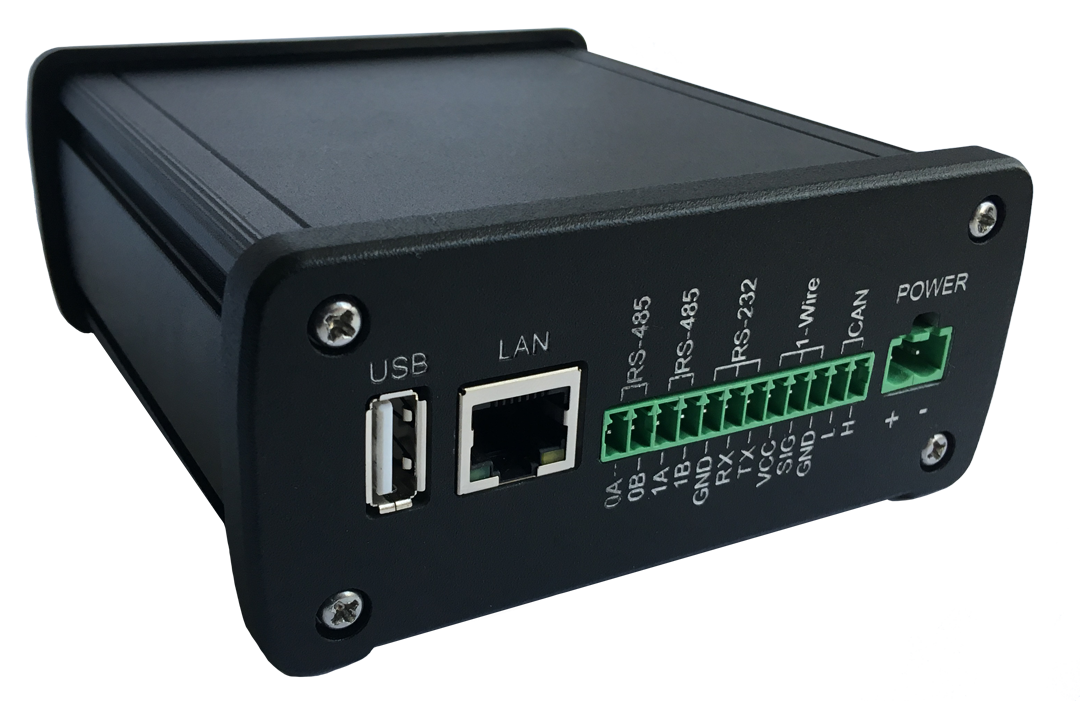
Figure 1 - Device Board
Great experience in the field of industrial automation and process control systems, it would seem, should contribute to the fact that over time I have already seen a lot of things and know a lot of things. But it was not there. It turns out that sometimes tasks and projects may arise that are difficult to implement using standard tools. So, for one large project on monitoring and management in the “cloud” of one notorious plant N, it was necessary to find suitable iron. However, it turned out that in Russia, according to the requirements of the noise immunity of the device and the openness of the system, nothing suitable exists. An attempt to order a device ideally suited to us from abroad failed, because it is very difficult to introduce equipment marked “IoT” on an industrial scale into our country. Other suppliers did not arrange delivery periods of 12 weeks with small volumes and price. Therefore, in my head the thought of creating my device was born and firmly settled. And such that it was universal and suitable not only specifically for this one project, but for many others. As a result, a lot of time has passed from the moment the idea was born, the selection of suppliers and the case, the development of the board, its debugging and testing, writing instructions and technical documentation. But now I am holding with a thrill in my hands a fully finished and working device, and I can say that we did it!
Why Raspberry?
Raspberry Pi is a small and cheap universal microcomputer that can be flexibly configured for any task. Since 2014, it has been released as an independent Compute Module computing module, that is, from the familiar board with various interfaces and connectors, only the most important remains: a processor, ROM and RAM. This design allows you to use this device for any conceivable and inconceivable tasks, it all depends on the possibility of imagination to create a harness around the module. It is also worth noting that since the release of the first version of the device, three versions of the modules have already been released, and after the release of the Raspberry Pi 4, you can probably expect the fourth version in the near future. All this suggests that developers are actively developing their product, increasing its power and speed, and that their device is very popular among people. This popularity is not groundless: for all this time they have established themselves as reliable devices capable of solving tasks of various levels in any conditions, even in space . It is also conditionally simple to program on the Raspberry Pi, they have a large number of integrators around the world.
The open Linux operating system allows you to install absolutely any software on the device, depending on the required task. For example, for solutions in the field of smart home, docking with OpenHab, Home Assistant, iRidiumMobile, NodeRed, etc. is possible (an example of using a device for a smart home can be found here ). For industry, it is possible to install SCADA-systems, such as CODESYS, Rapid SCADA, OpenSCADA with the ability to use the device as a gateway to transfer data to the upper level using the MQTT, http, REST API or CoAP protocols. Integration with various cloud services is also possible.
What are the interfaces?

Figure 2 - View of the board from above and below
The device in minimal execution supports the following interfaces:
- RS485 x 2;
- RS232 x 1;
- CanBus x 1;
- 1-Wire x 1;
- USB x 1;
- Ethernet x 1;
- SMA x 2;
- SIM x 1;
- miniPCIe x 2;
- HDMI 4k x 1;
- MicroUSB x 1;
- MicroSD x 1;
- GPIO x 1.
- LED x 1 (programmable);
The above interfaces allow you to implement the device in any project. And additional hardware modules for installation in Mini PCI-e slots from third-party manufacturers solve the problem with the availability of communication and Internet on the device. We chose this path with the installation of communication modules not by accident, since the presence of USB adapters (the so-called “whistles”) is not a very reliable and high-quality option, and installing industrial routers like Robustel R2000-3P is expensive (about 12 tr .). Therefore, we settled on installing two slots for Mini PCI-e modules, which can be used at will:
- 3G, LTE, GPRS module (HUAWEI MU709s-2, price: 2.5 tr);
- Wi-Fi module with the ability to connect a directional antenna to it;
- NB-IoT module;
- LoraWan module for building the Internet of things network.
Thus, there is a certain variability and flexibility in choosing the right communication interfaces for a specific task.
Additional solutions
- Hardware watchdog;
- Real-time hardware clock;
- Non-volatile memory EEPROM;
- Metal case and covers (3 mm aluminum);
- Power range 9-36 V;
- Temperature range -25 ... + 80 ° C (according to documents, tests have not been carried out yet).

Figure 3 - AntexGate device in the case
I would like to receive feedback from experts. And perhaps hear any advice or suggestions.